A few months ago I reported the maximum levels I found on a variety of LPs[1]. In order to get these results I had to calibrate the behaviour of the system I was using. I’ve continued to use my old Shure V15/III cartridge with an MR (Micro Ridge) stylus. I bought this back in the years BC (Before CD, that is). My notes tell me that I started using the MR stylus in 1987, so it has seen over two decades of service. Yet there have been no audible signs of problems. The low playing force, low tip mass, and high compliance of the V15 family mean that stylus wear is relatively light. However having decided that it was time for a more careful check. I also started to wonder – how would my antique compare with more modern choices? I suspect I am not the only old fogey who has preferred to keep on using an old cartridge that I like. But would those of us who’ve done this be better off with a modern replacement? How would modern alternatives fare as ‘drop in replacements’?
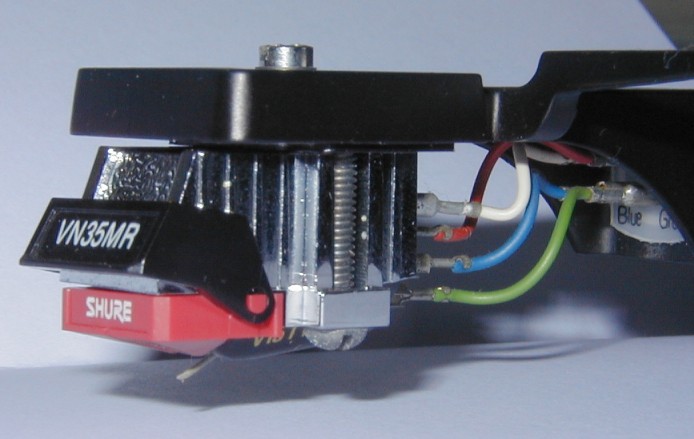
Click
here for a larger view
Shure V15IIIMR
Shure no longer make a V15, nor any replacement styli for them. But third parties like the Expert Stylus and Cartridge company can re-tip styli – or even replace the cantilever, if necessary. So it is possible to refurbish and go on using ‘orphan’ designs like the V15s if you wish. And other suppliers can provide ‘white box’ nominal replacement styli of uncertain parentage. There are various options available. Given my established old-fashioned liking for Shure moving magnet types the obvious choice for a new cartridge would seem to be the Shure M97xE. But perhaps there were alternatives I’d find were preferable? I therefore decided to expand the checks on my Shure V15/III to investigate and compare with some of the choices available.
Figure 1
My starting point was to carry out a set of measurements on my V15/IIIMR to see if was working OK. Figure 1 shows the main results obtained using the Ultimate Analogue Test LP which is produced by Analogue Productions. This particular LP has some useful bands if you have suitable measurement equipment. For example, it has some stepped frequency sweep bands which I used to obtain the results shown. Note that for all my tests I used a standard loading of 47kOhms in parallel with approximately 280pF. This was established as pretty much the standard for moving magnet types like those from Shure.
Figure 1 (and the later results) include four graphs. One shows the frequency response of the cartridge. Ideally, this should be a pair of flat lines along the ‘0dB’ level. In practice, though, most cartridges show departures from a flat response. Typical results show a ‘dip and peak’ due to mechanical resonances, etc, in the system. With care, this behaviour can be flattened out to a large extent by the choice of the optimum electrical loading. The plot next to the frequency response shows how the distortion for a 315Hz mono (lateral) sinewave varies as we increase the amplitude of the sinewave. For this the ‘0VU’ level means 5cm/sec on both the left and right channel. This means that ‘0dB’ here actually corresponds to around 7cm/sec mono due to the geometry of the way the left and right signals are recorded on a stereo LP. The lower pair of plots display the distortion as a function of signal frequency. One is for a low frequency sweep at 0dB. The other for a high frequency one at the -20dB level. The low frequency sweep shows distortion mainly caused geometric factors and nonlinearities in the cartridge’s magnetic circuit. The HF sweep is more sensitive to mistracking and distortion due to groove deformations caused by high stylus pressures on the vinyl. Note, though, that the HF distortion results in particular are very sensitive to the precise setup, so it is hard to get definitive values for this!
If you look at the plots in Figure 1 they show the classic behaviour for a V15 moving magnet. Having carried out a full set of measurements I was pleased to see that there were no signs of any stylus wear or other degradations. The results were excellent. For example, the original crosstalk spec for the V15/III was better than 25dB at 1 kHz. When I measured this I got over 30dB with distortion included, and over 35dB if I only considered the 1 kHz tone! The results show that despite its age the V15/IIIMR was working very well.
In addition to the MR stylus I had kept two previous HE (Hyper Elliptical) styli (type VN35HE) as backups just in case the MR failed. I therefore decided to get these checked out by the Expert Stylus people. When I arranged this I assumed that at least one of them would be sufficiently worn or degraded that a replacement or refurbishment would be in order. However the report from examination was that both of them were in good condition and were still useable. Out of curiosity I therefore replaced my MR stylus with one of the HEs and did another set of tests. The results, shown in Figure 2, are almost identical to those for the MR. Again, the ancient stylus seems to work very well and deliver textbook results. Quite a testament to the original manufacturing quality!
Figure 2
In both cases I used a playing weight (downforce) of 1·3grms. The HE stylus does show a slight tendency to higher distortion for frequencies above about 5kHz, but it wasn’t clear if this was due to the different stylus profile or a slight error in my alignment of the system.
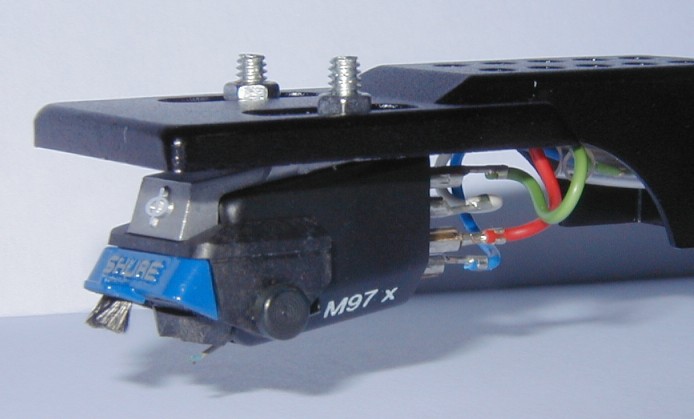
Click
here for a larger view.
Shure M97xE
I then moved on a new Shure M97xE and obtained the results shown in Figure 3. Again the playing weight was 1·3grms. The M97xE has a ‘damper’ brush that is designed to damp down the LF arm/compliance resonance. I clipped this damper ‘up’ and out of use for the measurements shown in Figure 3. (When I tried using the brush with the recommended higher playing weight the results were quite similar to those shown in Figure 3.)
Figure 3
Comparing this with Figures 1 and 2 there is a clear ‘family resemblance’. However it can be seen that the M97xE has a tendency to slightly larger frequency response variations than the excellent V15/III. The stereo separation values I measured for the M97xE were only around 17dB at 1 kHz. This is much poorer than for the V15, and doesn’t meet the value of 25dB quoted in the leaflet which came with the M97xE. I also found that the sensitivity was slightly lower than for the V15. As a result the M97 gave about 1dB less output at 1kHz, whereas the printed spec indicated it should be more sensitive. I therefore obtained a second sample, and repeated some of the tests, only to get similar results. After some investigation, Shure USA informed me that the specs of the M97xE had actually been changed, and that the rated separation is now 17dB. This value is adequate for decent stereo, but quite a come-down from the 30dB values provided by the old V15!
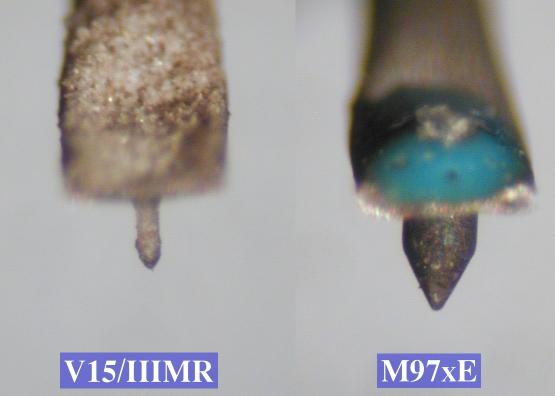
Click
here for a larger view.
Figure 4
Although broadly similar in terms of the measured results, a careful look though a microscope revealed that the V15/IIIMR and M97xE styli are very different! Figure 4 shows images of the styli, photographed using the same optical magnification. You can see that the MR stylus is much smaller than that used for the M97. The M97 also apparently employs a noticeable (greenish-blue) blob of adhesive to help bond the stylus to the cantilever. Overall, the impression given is that the MR stylus will have a lower effective mass than the M97xE. If you look carefully at the MR image you should just be also to see the shape of the playing surfaces of the tip profile as a darker region around the tip.
Having examined the M97xE I felt it would be useful to look at some modern moving magnet designs from other makers. As I already had a Rega Exact MM cartridge to hand I decided to choose this as a British example, leaving me to choose a final example from elsewhere.
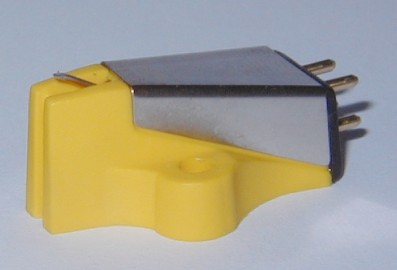
Click
here for a larger view.
Rega Exact
Now, Ortofon are a well established cartridge manufacturer whose designs have an impressive history reaching back to competing with the V15 series. Although Ortofon have become particularly well regarded for moving coil designs their new ‘M2’ (Moving Magnet) series has been well received. So I obtained an M2 Black and used that as the final example for my comparisons.
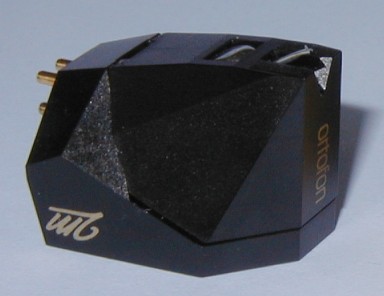
Click
here for a larger view.
Figure 5 shows results obtained from the Rega Exact. In this case I used the playing weight of 1·75 grms as recommended by Rega.
Figure 5
It can be seen that the Exact exhibited higher levels of distortion and greater variations from a flat response than the Shures. The channel seperation at 1 kHz for the Exact was 26dB in total and 30dB if distortion is excluded. These are good figures, much better than the Shure M97xE.
I think it quite likely that a load of 47kOhm//280pF is far from optimum for the Rega Exact. A different loading that helped to flatten the response would also reduce the HF distortion values because these are probably enlarged by the peaked response. Hence the results should not be taken to represent what the Exact can do in a situation optimised for its use. Unfortunately, Rega’s leaflet for the Exact does not specify either an expected frequency response, nor a specific recommended load impedance, so it is difficult to know what the optimum results should be. The ‘droop’ in the 3-10 kHz region may well have an audible effect. I did show the above results to Rega who sent me another Exact in case the one I had was not typical. But when tested the second example gave broadly similar results.
The Exact may well be fine for many applications and suit many users and setups. However since I was interested in a ‘new versus old’ comparison based on the V15 as a reference I simply used the loading which is optimum for older designs. On that basis it did not seem to me suitable as a replacement for a V15. But this conclusion might change if a different loading were found that made a significant difference to the performance. I must confess, though, that as a personal preference I dislike using playing forces in excess of 1·5 grams as I am wary of record wear.
Figure 6
Figure 6 shows results for the M2 Black, using the Ortofon recommended playing force of 1·5grms. Again I stayed with a loading of 47kOhm/280pF. This also shows signs that it would be better used with a different loading. Indeed, when I showed the results to Henley Designs for comment they suggested that the behaviour would be better with a slightly lower load capacitance around 250pF. This seems quite likely to me and I expect a much flatter response, and lower distortion, could be obtained by careful alterations of the setup. Using the standard V15 loading the behaviour up to around 5kHz is good, but above that there is a modest response peak above this which also tended to enhance the HF distortion. In this case the stereo separation was 25dB in one direction and 30dB in the other at 1 kHz. I suspect I could have improved these results if I’d spent more time on making minor adjustments, and perhaps increased the playing force a little, but even simply using the V15 setup the results seemed quite good. The M2 Black was also markedly more sensitive than the V15s and gave about 5 dB more output at 1kHz.
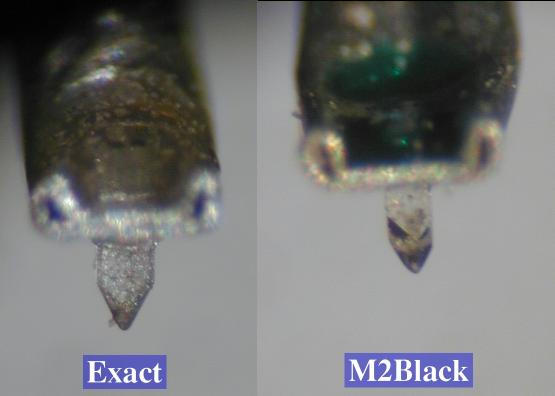
Click
here for a larger view.
Figure 7
Figure 7 shows another pair of microscope images, taken with the same optical magnification as before. You can see the shaping of the tips of these designs. In the case of the Exact this is a “Vital” shape said to give extended contact. The M2 Black has a nude tip with a “Shibata” profile which is widely regarded as an excellent stylus shape. These styli do look much more impressive than that used for the Shure M97xE. However as the measured results indicate, there is more to getting good results than using a named profile!
So what conclusions can we draw from the above comparisons? On the simplest level the results showed that if you were starting with a setup optimised for a Shure V15 and wanted a replacement with a minimum of fuss, then the most obvious choice might be appropriate. i.e. to stay with the same manufacturer and go for a Shure M97xE. However one of the alternatives might well be preferred if other conditions (e.g. loading) could be altered to suit, or if you are unimpressed by the appearance of the M97xE stylus and the cartridge’s limited stereo separation. If my MR/HE ceased to be usable I’d be torn between simply using the M97xE as a ‘no fuss’ replacement or experimenting with the Ortofon M2 Black with modified loading to get optimised results. There is no doubt that the M2 Black stylus looks much better than the one used on the Shure M97xE, but I can’t decide if that actually matters given that the M97xE delivers decent results, albeit let down by poor channel separation.
Alternatively, you might well find that a retipped or third-party replacement stylus was a good option. I haven’t had space to examine that here, but various people like the Expert Stylus and Cartridge Company have a good reputation for this kind of thing, so would we well worth consideration if you wish to keep an old and well-liked cartridge in action. Again, I’d personally be inclined to try this before changing to a new design.
On a more general level, the main conclusion I would draw is that choice isn’t a simple matter because the results depend on interactions between the cartridge and its conditions of use. Alas, many manufacturers these days don’t really give much guidance as to what the optimum setup may be, nor give much detail about what performance should be obtained. Shure still give a detailed list of specs in their leaflets. Although unfortunately it turned out that the specs for the M97xE had been changed so as to no longer meet the leaflet values! Manufacturers often make a song and dance about things like the stylus profile or choice of cantilever material. But unless you can also optimise other factors you may not benefit from these. A superb stylus profile doesn’t guarantee, say, low distortion, unless everything else is right. So all being well, I hope to investigate this further in a future article.
2400 Words
Jim Lesurf
9th Mar 2008
[1]
HFN Investigation February 2008 pages 105 - 111





